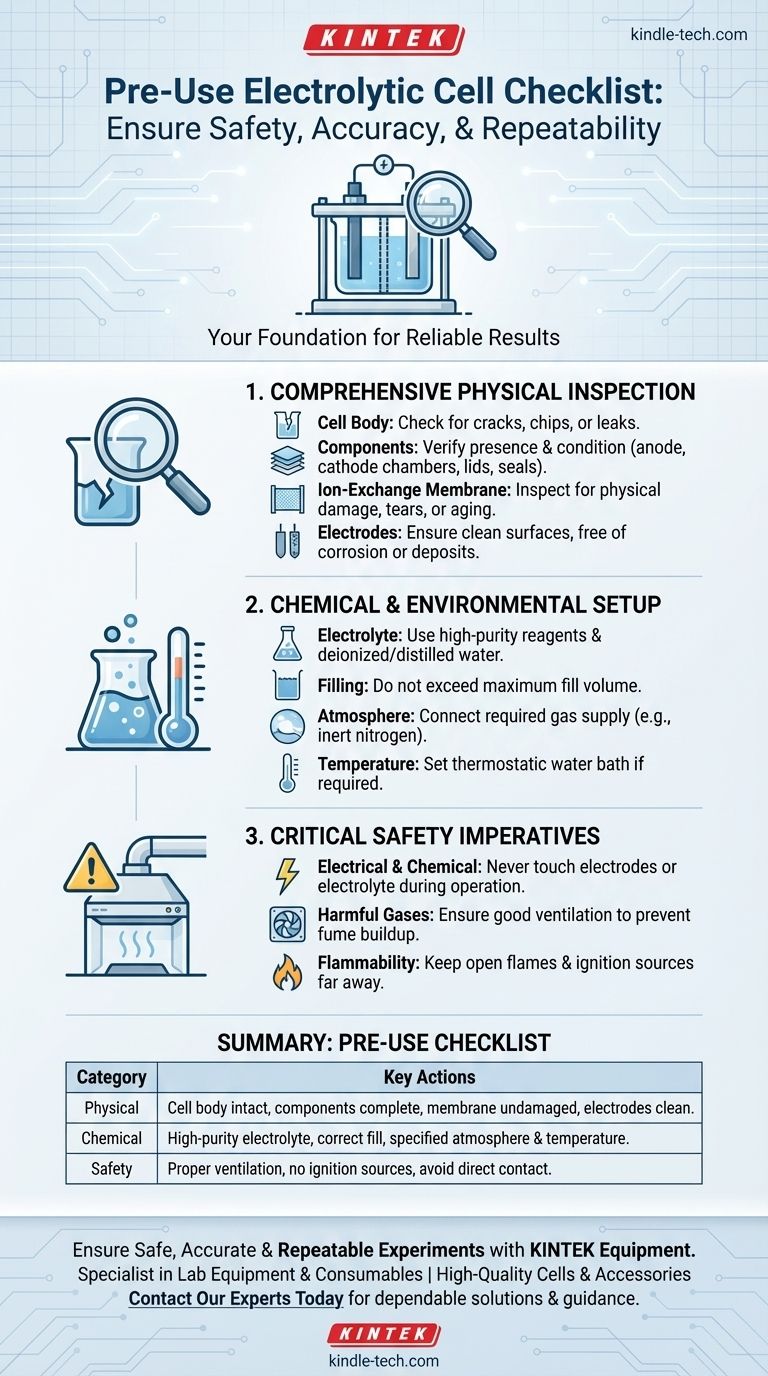Before using an electrolytic cell, you must perform a thorough inspection of its physical and chemical components. This includes checking that the cell body is free of cracks or leaks, ensuring the electrode surfaces are clean and undamaged, and verifying that the ion-exchange membrane is intact and shows no signs of aging.
A pre-use inspection is not merely a procedural step; it is the foundational practice that ensures the accuracy of your results, the repeatability of your experiment, and, most critically, your personal safety.

A Comprehensive Physical Inspection
The integrity of the electrolytic cell is the primary prerequisite for a successful and safe experiment. Each component must be scrutinized before assembly and use.
Inspecting the Cell Body
The cell body, often made of glass, is the primary containment vessel. It must be handled with care to prevent breakage.
Before every use, carefully examine the entire cell for any cracks, chips, or leaks. A compromised cell body can lead to a loss of electrolyte and create a serious safety hazard.
Verifying All Components
An electrolytic cell is an assembly of precise parts. Confirm that all necessary components are present and in good condition.
This check includes the anode and cathode chambers, lids, and sealing rings. A missing seal or a mismatched lid can compromise the entire experiment.
Assessing the Ion-Exchange Membrane
The ion-exchange membrane is critical for separating the anode and cathode chambers, allowing only specific ions to pass through.
Inspect the membrane closely for any physical damage, tears, or signs of aging. A faulty membrane will lead to cross-contamination and invalid results.
Evaluating the Electrodes
The condition of the electrodes directly impacts the efficiency and outcome of the electrochemical reaction.
Ensure the electrode surfaces are clean and free of corrosion or surface deposits. If necessary, clean or polish them according to established procedures to ensure a clean, reactive surface.
Preparing the Chemical and Environmental Setup
With the physical apparatus verified, the next step is to correctly prepare the chemical and environmental conditions for the reaction.
Preparing the Electrolyte
The purity of your electrolyte is paramount. Impurities can introduce unwanted side reactions and skew your data.
Use high-purity chemical reagents and deionized or distilled water to prepare the solution.
Filling the Cell Correctly
Once prepared, pour the electrolyte into the appropriate chambers. Be careful not to exceed the maximum fill volume, as this can lead to spills during operation.
Establishing the Atmosphere and Temperature
Many electrochemical reactions are sensitive to their environment.
If your experiment requires a specific atmosphere, such as an inert nitrogen environment, ensure the gas supply is connected and ready. If it requires a constant temperature, a thermostatic water bath should be prepared and set.
Critical Safety Imperatives to Observe
These checks are directly tied to mitigating the inherent risks of working with electricity and chemicals. Ignoring them can have severe consequences.
The Risk of Electrical Shock and Chemical Burns
An electrolytic cell combines electricity and conductive, often corrosive, liquids.
Never touch the electrodes or electrolyte directly during operation. The initial check for a leak-free cell body is your first line of defense against chemical burns.
The Danger of Harmful Gases
Electrolysis can produce various gases, some of which may be toxic or flammable.
Ensure your work area has good ventilation at all times. This simple precaution prevents the buildup of potentially hazardous fumes.
The Hazard of Flammability and Explosion
Gases like hydrogen can be produced, creating a flammable or explosive atmosphere.
Keep all open flames or ignition sources far away from the electrolytic cell during operation.
Your Pre-Use Checklist for Success
Your preparation strategy should align with your primary objective for the experiment.
- If your primary focus is safety: Prioritize inspecting the cell body for cracks, ensuring good ventilation, and confirming all electrical connections are secure.
- If your primary focus is experimental accuracy: Concentrate on the purity of the electrolyte and the cleanliness of the electrode surfaces.
- If your primary focus is repeatable results: Verify that every component, especially the ion-exchange membrane, is in perfect condition and that environmental controls like temperature are stable.
Thorough preparation is the hallmark of professional scientific work and the foundation for a successful outcome.
Summary Table:
| Check Category | Key Actions |
|---|---|
| Physical Inspection | Check cell body for cracks/leaks; verify electrodes are clean; inspect ion-exchange membrane for damage. |
| Chemical Setup | Prepare high-purity electrolyte; fill chambers correctly; set up required atmosphere (e.g., nitrogen) and temperature. |
| Safety Protocols | Ensure good ventilation; keep ignition sources away; avoid touching electrodes/electrolyte during operation. |
Ensure your lab's electrolysis experiments are safe, accurate, and repeatable with reliable equipment from KINTEK.
As a specialist in lab equipment and consumables, we provide the high-quality electrolytic cells and accessories your laboratory needs for precise electrochemical research. From durable cell bodies to high-purity reagents, our products are designed to meet rigorous standards.
Contact our experts today to discuss your specific laboratory requirements and discover how KINTEK can support your success with dependable solutions and expert guidance.
Visual Guide

Related Products
- Double Layer Five-Port Water Bath Electrolytic Electrochemical Cell
- Electrolytic Electrochemical Cell with Five-Port
- Double-Layer Water Bath Electrolytic Electrochemical Cell
- Quartz Electrolytic Electrochemical Cell for Electrochemical Experiments
- H Type Electrolytic Cell Triple Electrochemical Cell
People Also Ask
- How should the electrolytic cell be connected to external equipment during an experiment? A Step-by-Step Guide
- What inspection steps should be performed before using the electrolytic cell? A Guide to Safe & Accurate Experiments
- What safety precautions should be taken during an experiment with the electrolytic cell? A Guide to Preventing Shocks, Burns, and Fires
- What regular inspection and maintenance activities are required for the electrolytic cell? Ensure Reliable Results & Extend Equipment Life
- What is the applicable temperature range for the electrolytic cell and how is the temperature controlled? Achieve Precise Electrochemical Results



















